
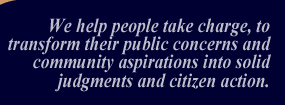
 |
 |
Henry Sanoff AIA
College of Design, North Carolina State University
and
Celen Pasalar
College of Design, North Carolina State University
Dilek Yildiz
College of Design, North Carolina State University
May 2001
Introduction
Waterfront planning and development has become a field in its own right, not
unlike historic preservation. Until recently, American cities have neglected
the opportunities of their waterfronts compared to European cities. After World
War II, a number of factors came together to affect the urban waterfront and
set the groundwork for the waterfront phenomenon of the present era.
Owensboro is a relatively compact small town (population 54,000) bounded on
the north by the Ohio River. In the early years, the economic base was distilling
and buggy manufacturing. Today tobacco and farming are important to the region,
which has a diversified economy.
The downtown is in the north central riverfront section of the city. Downtown
Owensboro has struggled in appearance and vitality since a retail mall opened
on the city's south fringe in 1978. Government, legal, and banking uses are
prevalent. Owensboro's riverfront has primarily been used for industrial purposes
with a few exceptions such as a downtown hotel/convention center, a performing
arts center and a small downtown park. Riverfront events and activities have
been limited to festivals and concerts, and seasonal boating.
In 1996, the Public Life Foundation of Owensboro was formed to support citizen
action in tackling community problems, since citizens are often left out of
the community's decision making process. The Foundation believes that informed
and engaged citizens can influence decisions and public policy. PRIDE, a new
grass roots group organized by the Public Life Foundation in 1999, was specifically
formed to create more public involvement in projects that impact on the appearance
of the community. Reaching more people and getting ideas from diverse backgrounds,
they believe, can help to build more support.
Community building is a holistic approach that focuses its efforts on people.
It is dedicated to the idea that citizens must take control of their destiny
and that of their communities. Community building grows from a vision of how
communities function normally, where community members create community institutions,
that help to achieve their aspirations as well as strengthen community fabric.
Building social capital is the primary objective achieved by citizens playing
a central role in decision making and believing that they "own" the
process as they move away from being dependent. Many case experiences suggest
that citizen-driven initiatives have a greater chance of success because citizens
are more aware of the realities of their own community than outside professionals.
They have a sense of what will work and what will not work.
One of the high profile projects in the community is the riverfront development.
Previous city efforts at urban renewal and development have met with community
resistance and very little action. Renewed interest by the City officials, the
Chamber of Commerce, Downtown Owensboro, Inc., and the Downtown Business Association,
in the potential amenities and income afforded by the riverfront led to the
city's proposed plan for developing the riverfront, which was approved by the
U.S. Corps of Engineers. City officials say that they plan to build a riverfront
that will enhance downtown, encourage private development and business and promote
Owensboro as a boater's destination. The development proposal included a boat
launch, marina and dock facilities, a floating walkway and garden. The city
has secured $2.8 million in state and federal funds for the development, but
it is estimated that $7 million will be needed. To begin the planning process,
an eight-member selection committee was formed by the city officials to solicit
proposals for the development of the riverfront. Four teams were interviewed
and the consulting firm of EDSA was selected to develop the master plan for
the riverfront.
Community Awareness and Participation Methods
City officials have subsequently embraced a partnership with PRIDE to significantly
expand citizen participation in the planning and design of the riverfront. PRIDE
wanted to create venues for public discussion about how the riverfront should
look and where activities should be located. PRIDE volunteers took the riverfront
project "to the people" through a variety of activities.
Student projects, including drawings, essays, wish poems, and model building.
The PRIDE Education Committee includes teachers from each local school to represent
the ideas of students. After meeting at a PRIDE get-together for educators,
an elementary school teacher and a high school teacher joined forces to generate
and build ideas for the riverfront. The primary students brainstormed ideas
while the high school students set about deciding which of the children's ideas
they could actually build. After exchanging letters and getting to know their
older "co-workers", the students embarked on a field trip to actually
construct a working model of the riverfront ideas. Students were asked to fantasize
what they would like to see available. Ideas included a Worship by the Water
community church, floating playgrounds, a bait shop and aquarium in the shape
of a fish, parasailing, and a "cave" down under the river for children
to explore and play. Commitment to create a unique learning opportunity has
enabled collaboration between the teachers and schools and facilitated involvement
in the community outside their walls.
Surveys were also conducted at the Daviess County High School where students
had the opportunity to share their ideas for the riverfront. Student involvement
in the planning stages is recognized as an important factor in strengthening
local economic conditions for the future allowing graduates to remain in Owensboro.
Other student activities included sketches of the riverfront generated by a
group of elementary students after a brief field study while visiting the Riverpark
Center.
Idea sharing sessions with neighborhood groups, interest groups and clubs.
The goal of these idea-sharing meetings was to gauge the opinions and views
of a cross-section of citizens about the riverfront and its future development.
In the twelve focus group sessions PRIDE volunteers asked people:
• What they now enjoy doing along the riverfront.
• What they would like to do if facilities and programs were available.
• What they like about waterfronts in other cities.
From the focus group sessions the most frequently reported activities desired
along the riverfront were to:
• Gaze at the river in a safe comfortable setting
• Attend festivals and concerts
• Eat and drink overlooking the river
• Walk along the water's edge
• See arts and crafts activities
• Walk from Smothers Park to English Park
Suggestions for how the riverfront could be made more attractive included gardens,
terraced riverbank, special lighting, more commercial development and public
space, and new development along Veteran's Boulevard (First Street). Along the
riverfront participants in the focus groups would like to see restaurants, an
entertainment district, retail shops, condominium apartments, and mixed use
development.
Newspaper feature stories, columns, and survey. A newspaper survey was
conducted with the following questions:
• What two features do you like most about Owensboro-Daviess County's riverfront?
• What two features do you like least about Owensboro-Daviess County's
riverfront?
• What do you enjoy doing now at the riverfront?
• What would you enjoy doing if facilities were available?
• About how many times a year do you visit the riverfront?
Survey results indicated that the parks, boat ramp and Riverfront Center were
the features most liked, while the river view, boat watching and the peacefulness
of the area were its attributes. Attending festivals, concerts and river watching
accounted for the most sources of enjoyment. If facilities were available, a
riverwalk would be most preferred, although boating, dining, and picnicking
were also identified as important considerations.
Riverfront Development Workshop
A community workshop is based on the viewpoint that professionals have an expertise
that is different from that of citizens. Citizens have an expertise in identifying
problems not necessarily solving problems. Collaboration is effective when all
participants in the process share their areas of expertise with one another.
Participation does not imply that there is no longer a role for institutional
leaders. It only means that a dialogue is necessary between grass roots citizenry
and government leadership regarding needs and resources to meet needs.
Consequently, the riverfront development community workshop provided citizens
with an opportunity to share their views with representatives of the planning
firm before developing the master plan. The workshop, held at the Riverfront
Center, was an open invitation to citizens of Owensboro-Daviess County to begin
a planning process by clarifying objectives, identifying appropriate activities,
and locating desired activities on a base map of the riverfront. One hundred
and thirty people attended the Saturday morning workshop.
The workshop opened with welcoming remarks from the mayor and key officials.
Participants then revisited the riverfront through a narrated photographic tour,
followed by a presentation of the students' vision, and ended with a video summary
of the focus groups. The "hands on" planning aspect of the workshop
consisted of twenty-two workgroups consisting of five people each, identifying
appropriate objectives for various sections of the riverfront. Objectives were
key factors in allowing participants to generate appropriate riverfront activities,
which they located on a base map of the riverfront through the use of graphic
symbols.
The riverfront was divided into four sections starting at the Riverfront Center
and extending to English Park. Workgroups were asked to individually select
the three most important objectives for each section, then through discussion
arrive at agreement to those most important. When agreement was reached, the
groups then matched activities to each objective, then locate the activity,
represented by a graphic symbol, to the appropriate location on a base map of
the riverfront. The most frequently cited objectives for the entire riverfront
were:
• Establish a continuous riverfront walkway
• Create a visually pleasing order to the river's edge
• Attract people and investment to the riverfront
• Develop an arts/entertainment district
• Expand leisure and recreational use of the river and riverfront
• Emphasize pedestrian streets that connect to the riverfront
• Provide housing for people in a wide range of income categories
• Accommodate outdoor performances
• Provide opportunities for boat launching and storage
The first two objectives received the largest number of votes and were identified
as important in three of the four riverfront sections. Riverfront activities
receiving the most agreement among participants were:
• Retail shops
• Restaurants
• Riverfront walkway
• Bicycle trail
• Jogging trail
• Boat launch
• Picnic area
• Preserve historic building (jail)
• Garden
The listing of priorities for each section of the riverfront are as follows:
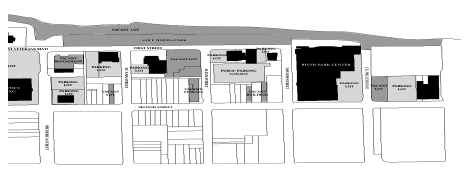
| OBJECTIVES | ACTIVITIES | |
| AREA ONE | Attract people and investment to the riverfront Create a visually pleasing order to the riverfront Develop an arts/entertainment district |
Arts and Crafts Retail shop Restaurant Park Riverwalk |
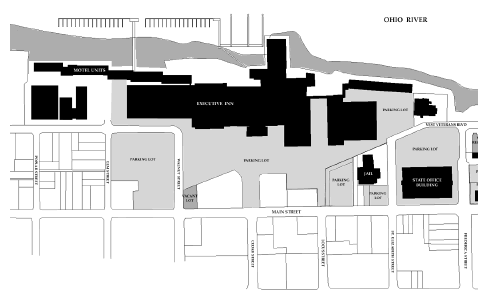
| OBJECTIVES | ACTIVITIES | |
| AREA TWO | Create a visually pleasing order to the riverfront Establish a continuous riverfront walkway Expand leisure and recreational use of the river |
Riverwalk Marina Jogging Retail shop Historic Preservation |
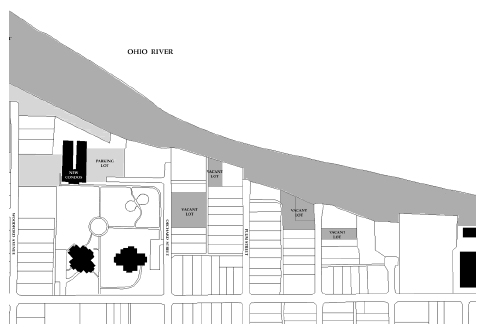
| OBJECTIVES | ACTIVITIES | |
| AREA THREE | Establish a continuous riverfront walkway Provide housing for people in a range of incomes Create a visually pleasing order to the riverfront Emphasize pedestrian streets that connect to the Picnic area riverfront |
Bicycle trail Jogging Riverwalk Garden Park |
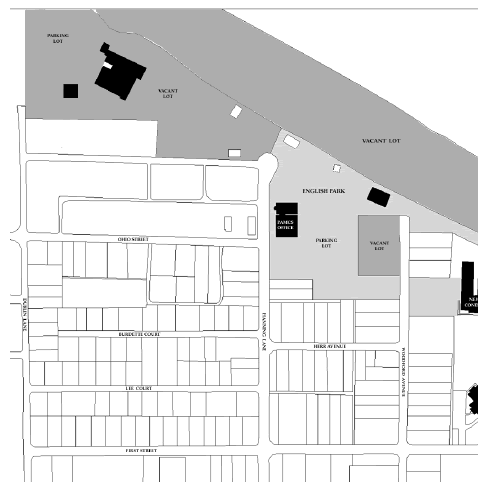
| OBJECTIVES | ACTIVITIES | |
| AREA FOUR | Accommodate outdoor performances Provide opportunities for boat launching Establish a continuous riverfront walkway Expand leisure and recreational use of the river |
Marina Watersports Picnic area Boating Park Playground Outdoor amphitheater Fishing |
The locations of the activities most frequently cited are shown on the base map of the riverfront. It can be observed from the placement of activities on the map that several key privately owned properties were identified for alternative uses. Since many key properties along the riverfront are privately owned further discussions are necessary with property owners as the master plan unfolds. Lessons learned from other riverfront development projects suggest that to achieve success requires a community building effort based on public -private partnerships.